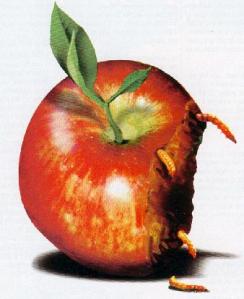
Most classroom failures fade in my memory from specific incidents to grimace over to merely, “That kid was a handful.” or, “December was not a stellar month for me.” However, one still stands out pretty well. Let this be a lesson for us all.
We shall call this cute tyke “Rickey.”
Angelic behavior was not something I had come to expect from Rickey. A couple weeks prior I had received an email from the principal instructing me to not allow Rickey to leave my classroom for bathroom visits ever again after I allowed him to go one period and he ran through the hallways banging on other classroom doors. Oops.
So here we are in class once more and I recall being very occupied with some activity. This wasn’t a day when students were working independently. Well, while I was distracted with something (probably inconsequential), Rickey stole a bottle of White-Out off my desk. No, not because he was working on a paper ever so diligently and wanted it to be perfect. Nope. Rickey stole it so he could paint a big-ole mustache on his face.
After he had donned his mustache, which I must admit he did a pretty fine job of without a mirror- and it was big, ornate, with curly tips, he quickly wanted to show off his new style to basically every student outside my immediate line of vision. After a few minutes, I began to pick up on the fact that I was no longer the focal point in the room (gasp!) and there was a little too much laughter and talking going on. Then I saw him….Rickey- out of his seat, near the front of the room, looking like a young Snidely Whiplash, absolutely basking in the audience he had created.

Back to the teacher’s corner in the ring- what do I do? I bark at him to get a tissue and wipe it off. Uhhh, yeah. White Out doesn’t wipe off. That’s sort of the point. I wasn’t thinking too logically at this moment though. I was irritated and acting mad- basically breaking the golden rule of classroom management- “Don’t let the students think they have accomplished getting under your skin.”
Well, Rickey gets his tissue and returns to his desk. Obviously this isn’t going to work though. The White-Out won’t come off. Also, the other students are highly entertained by this activity and they can’t focus on anything else. Then, Rickey raises me one. He starts complaining about how the White-Out is burning his skin. “Ahhh! It burns! My face is on fire!” The room erupts in laughter…well, except for me.
Anger has taken away my rationality. So I get onto the rest of the class for talking and laughing. However, that is like drinking mouthwash because you are thirsty. It seems right, but is very wrong. It doesn’t address the root of the problem with something that can solve the problem. Why bother punishing off shoots of the problem, instead of cracking down and dealing with the actual problem? Back to the situation though- I really felt like making him sit there and burn- but that was way to mean. But wait- he wasn’t allowed to leave the room because of the earlier offense! Now it felt like Sophie’s Choice- should I risk a hurt kid on my hands if suddenly his face explodes into allergic White-Out boils or should I risk not following the principal’s orders?? Bahh! I felt like it had to be decided right then in the next 2 seconds or my brain would explode. The noise from the other students was rattling my nerves…. I let him go to the bathroom.
Now for the 20/20 perspective:
I shouldn’t have gotten angry. That made it worse. I just should have dealt with the child promptly and that would have fixed everything. How you ask?
- Tell him to bring me the White-Out (thank you, I’d like that back!) and come sit next to me at my desk. This removes him as a distraction from other students.
- Refocus the students back on whatever task they should have been doing. This should have been the ultimate main priority: learning. White-Out boy can chill in time out for now.
- Page the office and ask for the vice-principal to escort him to the bathroom. Allow the vice-principal the option of writing the student up (and make him sweat please!).
See, aren’t those rational actions? By getting angry I let the naughty kid take control of my emotions and my classroom. Keep your cool, take some time to think if you need to- don’t feel rushed, and handle it logically.
And when you look back on it, a White-Out mustache is kinda funny….


















